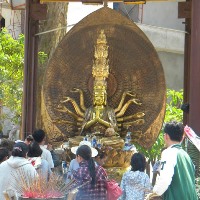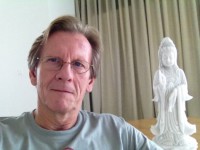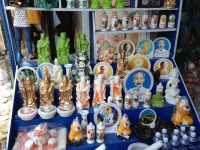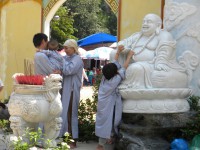Bodhisattvas
My Shambhala friends of course know about Bodhisattvas. For other friends who don’t, I tell them it’s a being who has attained a high level of spiritual realization, is just on the verge of ultimate enlightenment, but who chooses, instead of going beyond, to stay behind and help relieve the suffering of other beings.
Perhaps the best known is the Bodhisattva of Compassion, whose Sanskrit name is Avalokitesvara, and who features in some  of the most revered Buddhist sutras. The Heart Sutra, with its cryptic passage “form is emptiness and emptiness is form,” is ascribed to Avalokitesvara, and the famous mantra om mani padme hum is associated with him…..or her as it may be. There are many manifestations of Avalokitesvara, both male and female, one showing a figure with 1000 arms and 1000 eyes to see and help all the suffering multitudes. The Dalai Lama is considered an incarnation.
of the most revered Buddhist sutras. The Heart Sutra, with its cryptic passage “form is emptiness and emptiness is form,” is ascribed to Avalokitesvara, and the famous mantra om mani padme hum is associated with him…..or her as it may be. There are many manifestations of Avalokitesvara, both male and female, one showing a figure with 1000 arms and 1000 eyes to see and help all the suffering multitudes. The Dalai Lama is considered an incarnation.
I have a personal interest in Bodhisattvas. For years I had a Nepalese thanka on my wall, a gift from a friend, of the 1000-armed Avalokitesvara without actually knowing who it was or what it represented. And after declaring myself a Buddhist by taking the refuge vows with Acharya Richard John, I took the Bodhisattva vows a year later, again with Acharya John, a further commitment to the Mahayana path.
 So I was intrigued upon arriving in Danang to discover the ubiquitous presence of one of the female manifestations of Avalokitesvara—the tall graceful figure of Kwan Am, derived from Chinese origins and known variously as Kwan Yen or Guan Yin and other variations. There is a 200 foot statue of Kwan Am that overlooks China Beach, and she is found in pagodas everywhere. She is known as the Goddess of Mercy, a source of unconditional love and salvation, and the protector of sailors and fishermen.
So I was intrigued upon arriving in Danang to discover the ubiquitous presence of one of the female manifestations of Avalokitesvara—the tall graceful figure of Kwan Am, derived from Chinese origins and known variously as Kwan Yen or Guan Yin and other variations. There is a 200 foot statue of Kwan Am that overlooks China Beach, and she is found in pagodas everywhere. She is known as the Goddess of Mercy, a source of unconditional love and salvation, and the protector of sailors and fishermen.
One of the biggest local festivals is devoted to her, held every year at a large shrine in the nearby Marble Mountains. It proved to be a lively mixture of devotion, commerce, and just plain family outing: the faithful queuing up before Kwan Am and Avalokitesvara to bow and pray and light sticks of  incense; local officials and policemen mingling with monks in grey robes; lively musical performances; lots of little stands selling food and various Buddhist paraphernalia. I especially liked one where you could buy a commemorative plate picturing Buddha, Kwan Am, or Ho Chi Minh. Yes, he, too, is a religious figure here.
incense; local officials and policemen mingling with monks in grey robes; lively musical performances; lots of little stands selling food and various Buddhist paraphernalia. I especially liked one where you could buy a commemorative plate picturing Buddha, Kwan Am, or Ho Chi Minh. Yes, he, too, is a religious figure here.
The next most popular local deity seems to be the fat “laughing Buddha,” Bo Dai (Budai in Chinese), whose figure you may be familiar with. Like Kwan Am, he has Chinese origins. He was a Zen monk in the 10th century whose name means “cloth sack,” in one of which he carried his few possessions. He was considered a man of good and loving character, poor but contented. Somewhat ironically, in popular folklore today, rubbing Bo Dai’s belly on a visit to the pagoda is believed to bring good luck and prosperity.
 So there you have a glimpse of Vietnamese Buddhist practice…..supplicating Kwan Am for protection and rubbing Bo Dai’s belly for good fortune. More important to the Vietnamese, I’m told, is veneration of one’s ancestors — the most important practice of all.
So there you have a glimpse of Vietnamese Buddhist practice…..supplicating Kwan Am for protection and rubbing Bo Dai’s belly for good fortune. More important to the Vietnamese, I’m told, is veneration of one’s ancestors — the most important practice of all.
I’m pleased to report that there are now two Shambhalians in Danang. A few months ago, I received a call out of the blue from someone who had read my first blog post and tracked me down. Steve, hailing from the Berkeley CA sangha, is temporarily stranded in Vietnam while he awaits the lengthy U.S. visa processing of his Vietnamese fiancé, Thy. The three of us haven’t really practiced together yet, except eating Vietnamese food and commiserating about government bureaucracy, American and Vietnamese alike. But we have enjoyed that.
by Mark Rasmuson
